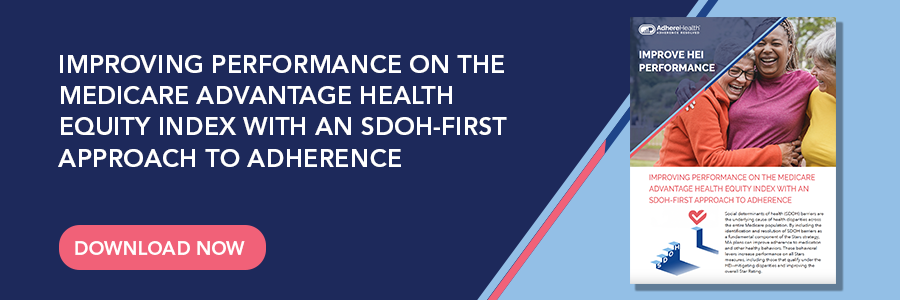Published on .
CMS is consistently evolving the Star Ratings system to ensure high-performing, high-value plan options for Medicare Advantage (MA) members. In the 2024 and 2025 measurement years, major changes to the rubric are slated or proposed to challenge health plans in a number of ways, bringing targeted focus to health equity and medication therapy management while raising the bar on overall performance with adjustments to the Quality Improvement (QI) Hold Harmless provision.
With so many new tasks to juggle, it’s easy to forget that small things can add up to big differences in performance, ratings and access to Quality Bonus Payment (QBP) opportunities.
For example, in the 2025 Advanced Notice, CMS added a reminder to plans of the Plan All-Cause Readmission (PCR) measure, which has expanded from a single-weighted measure to a triple-weighted measure for the 2025 Star Ratings, which reflect measurement year 2023.
While there’s nothing to be done about 2023’s performance at this point, the significant jump in weighting puts additional pressure on plans going forward—especially as competition gets more intense across the market and exceptional Star Ratings become ever more necessary to differentiate high-performing plans from their peers.
Using a combination of predictive analytics, personalized outreach and a concentration on medication management during transitions of care, MA plans can prevent avoidable readmissions and leverage the increased weighting of this measure to their advantage.
What is the Plan All-Cause Readmissions measure?
Medicare readmission rates average around 20%, and the associated costs exceed $17.4 billion for Medicare annually, making 30-day readmissions a pressing issue for members, payors and regulators alike.
The PCR measure assesses the percentage of hospital stays during the measurement year that were followed by an unplanned readmission within 30 days—a well-established proxy for the quality of inpatient care and the level of coordination when transitioning from the hospital to the home, or to a long-term care facility.
For this reason, the PCR measure is often viewed as a direct companion to the transitions of care (TRC) measure, which gauges the process of notifying the care team of admission and discharge, engaging patients after leaving the hospital and conducting medication reconciliation in a timely manner to avoid adverse events. If plans are able to complete these activities appropriately, they should have lower rates of preventable readmissions.
To make sure the plan is being judged fairly based on its member population, the PCR measure also requires plans to report a predicted probability of readmission for members to help calculate whether or not the plan had greater or fewer readmissions compared to what should be expected for the population’s health status.
While the PCR measure was previously retired from Stars, it’s now back in the mix as CMS crystallizes its focus on member experiences and outcomes. The increased weighting for 2025 and beyond simply serves to emphasize the importance of carefully monitoring the transition out of the inpatient setting, including keeping a close eye on medication safety and adherence during the often-chaotic move from one setting to the next.
Building your Star Ratings strategy? Check out our white paper to take action on health equity!
The role of medication adherence in avoiding 30-day readmissions
Managing medications after a transition of care is crucial for ensuring that members understand any changes made during their inpatient stay and are able to continue taking their medications as prescribed during the next phase of their care.
With more than 40% of medication errors tied to inadequate medication reconciliation during transitions of care, plans have a strong incentive to provide medication reconciliation services as quickly as possible after discharge to avoid confusion and get members back on track with adherence.
Establishing adequate adherence can have a major impact on the likelihood of an unplanned return to the inpatient setting. In 2017, a team from Cedars-Sinai Medical Center found that people with low and intermediate adherence experienced readmission rates of around 20% compared to a 9.3% readmission rate for those with the highest levels of adherence.
Conducting a thorough assessment of a member’s medications—and the surrounding clinical and non-clinical factors that might influence their ability to remain adherent to their prescriptions—is key for keeping members from returning to the hospital and improving performance on the PCR measure.
Best practices for improved medication adherence and PCR performance
Plans will need to utilize a combination of data-driven strategies and personalized outreach techniques to identify high-risk members, connect with these members in a meaningful way and resolve any medication-related issues that could contribute to an unplanned readmission.
1. Use technology to improve understanding of members at risk of readmissions
MA plans will need to invest in a technology platform that can proactively and accurately identify members at higher risk of readmissions using a variety of relevant data points. This data should include clinical information, pharmacy claims and socioeconomic datasets that could indicate vulnerabilities in the community, such as lack of easy access to a pharmacy. The platform should ingest claims data on a daily or weekly basis to ensure the most up-to-date information is available to telepharmacy outreach staff.
2. Uncover and resolve adherence challenges post-discharge
Using person-centered techniques like motivational interviewing, outreach staff can build authentic, supportive relationships with members. These conversations, which focus on the member’s goals and how to achieve them, must also include actionable solutions to resolve adherence challenges, including those rooted in socioeconomic or behavioral health barriers.
For example, this could include using the digital platform to connect members with referrals to community-based services for food stability or housing assistance, or provide links to counseling or therapy services included in the plan’s benefits to support improved behavioral and mental health after a disruptive hospitalization.
3. Conduct ongoing, longitudinal follow-up
While the PCR measure is primarily concerned with the immediate window of time after a transition of care, members still need support and monitoring after the initial 30 days is up. After all, CMS places even more emphasis on year-round medication adherence with a trio of triple-weighted measures that can have a profound impact on overall performance.
To keep members from re-entering the cycle of avoidable admissions, plans need to employ technologies that foster ongoing relationships with members year-round. Platforms should continually monitor claims for signs of adherence concerns and include features that make clinician notes accessible for use in future follow-up conversations. This helps to avoid friction with members during subsequent encounters.
By taking these proactive steps to connect with members quickly and comprehensively after a transition of care, MA plans can stay one step ahead of the medication adherence issues and other challenges that often lead to avoidable 30-day readmissions.
As a result, plans can perform better on the PCR measure, support better experiences and health outcomes for members, and achieve their 4.0+ Star Ratings goals.
Looking to improve your Star Ratings strategy? To learn how AdhereHealth helps Medicare Advantage plans like yours improve transitions of care and reduce readmissions through an SDOH-first approach to improved adherence (especially in your highest-risk, hardest-to-reach members), request a consultation today!

Kempton Presley, MPH, MS
AdhereHealth, Chief Strategy Officer

